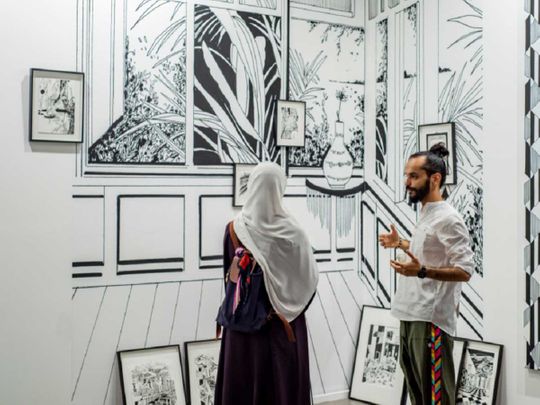
Cities that are home to a constellation of gorgeous art galleries are imbued with a sense of prestige and enjoy regular visits from arts enthusiasts locally and worldwide. Since time immemorial, civilisation has always regarded artworks on an exalted pedestal, commissioning pieces from protegees or established artists, and showcasing them for public admiration.
Indeed, a visit to an art gallery is a captivating and even life-transforming experience, ruminating upon historical and contemporary artworks that bestow us with essential meanings in their unique, creative ways. Not only that, but art galleries also play a pivotal role in preserving our collective cultural treasures and fostering cross-cultural dialogues over universally riveting pieces of art.
By the end of our visit, we feel a sort of rejuvenation of our spirits — we reflect on the beautiful messages of various artworks, remember how abundant our world is with beauty, and we are imbued with a feeling of elegance. Considering the collective benefits of arts immersion on our well-being, cities should regard art galleries as elemental in urban planning.
World-class art galleries
Many bustling creative cities are brimming with an enviable portfolio of world-class art galleries that showcase contemporary artworks by local, regional, and international creatives. To illustrate, the National Gallery in London houses a collection of over 2,600 paintings, encompassing works created by venerable Western European painters, such as Raphael, Leonardo da Vinci, Rembrandt, Paul Cézanne, Vincent Van Gogh, Pierre-Auguste Renoir, and Claude Monet.
On the other hand, the National Museum of Modern Art in Kyoto features Japanese-style paintings and Western art styles, with a mix of historic and modern artworks. It regularly hosts exciting exhibitions, such as the current exhibition themed around ‘Salon Culture and the Pictorial Arts of Kyoto and Osaka’, highlighting literati painters that fused their lyrical masterpieces with artistic renditions that are inspired by real-life imagery.
The Arab region is also witnessing a proliferation of up-and-coming and renowned galleries making their way to eager audiences. In recent years, for example, we’ve seen how numerous prestigious galleries opened up and expanded across several Arab countries — from the UAE, Saudi Arabia, and Beirut to Bahrain, Doha, and Kuwait. On top of that, arts aficionados are lured into home-grown, spectacular art exhibitions and fairs.
Earlier this year, the wonderful Dubai Art Season ran in its 15th edition with successful events, such as the Sikka Art & Design Festival, Art Dubai, and World Art Dubai. Abu Dhabi’s foray into the arts scene is opening up worlds of wonderful artistic expressions, fusing traditional works with more contemporary art pieces. In recent years, we have enjoyed spectacular exhibitions at the Louvre Abu Dhabi, Manarat Al Saadiyat, Etihad Modern Art Gallery, and Abu Dhabi Art.
Showcasing important historical artworks
Considering the extraordinary effects of the arts world on our communities, cities should instigate the proliferation of art galleries, artistic spaces, and creative hubs. Establishing national art galleries to showcase important historical and contemporary artworks is an elemental aspect of any city’s strategy to become a thriving artistic hub with a unique character.
This will ensure local communities have access to prominent and world-class artistic masterpieces, as witnessed by the opening of prominent gallery branches, such as the Louvre Abu Dhabi. Furthermore, financial backing can be secured in the form of public funding or subsidies, in addition to donations and grants from individuals, trusts, corporations, and foundations.
Part of the process of building up national arts collections should be focused on grooming local artistic talents and acquiring their works. Offering a proliferous menu of opportunities within professional university-level arts degrees or vocational training will ensure a sufficient and creative local talent base is thriving.
Furthermore, training professionals in the arts field would ensure the sector has skilled workforces, such as art gallery managers, collection curators, archivists, art conservators, or arts educators.
Arts galleries should also put in place robust marketing campaigns to create interest and engagement among audiences. Educational curricula could pique the curiosity and interests of arts enthusiasts by introducing them to arts-related subjects and activities from a young age. Doing so will pave the way for children to be equipped with essential artistic talents and build an appreciation for the arts world. Hand in hand, many arts galleries organise special events for school-age children in creative settings and themed around fascinating topics.
To illustrate, the National Gallery in London organises a number of exciting activities for children, such as tours and storytelling sessions focusing on prominent paintings displayed in the gallery and practical workshops to enhance creativity skills.
Additionally, individuals could enrol in one of their enlightening short courses, encompassing art history, spotlights on famous painters, and self-reflection on timeless masterpieces. Teachers can also access lots of excellent resources revolving around the arts, such as art tutorial videos, teachers’ notes focusing on famous paintings, and professional development sessions.
Art galleries must also direct their efforts towards creative engagement with audiences. Many prominent art galleries across the globe are luring loyal and frequent visitors via hosting exhibitions with fascinating themes, offering enlightening educational or skills-based workshops for the public, organising talks and seminars about prominent works or buying artworks, inviting renowned artists to speak about their artistic journeys, and holding captivating live performances set amid the galleries’ spaces.
Fostering partnerships with international art galleries will result in mutual exchanges of arts collections so that universal artistic messages can travel far and wide. Establishing a strong digital presence is also critical to reach out to communities.
Arts galleries certainly deserve a presence in our cities, considering their priceless contributions to mankind.
Sara Al-Mulla is an Emirati civil servant with an interest in human development policy and literature








